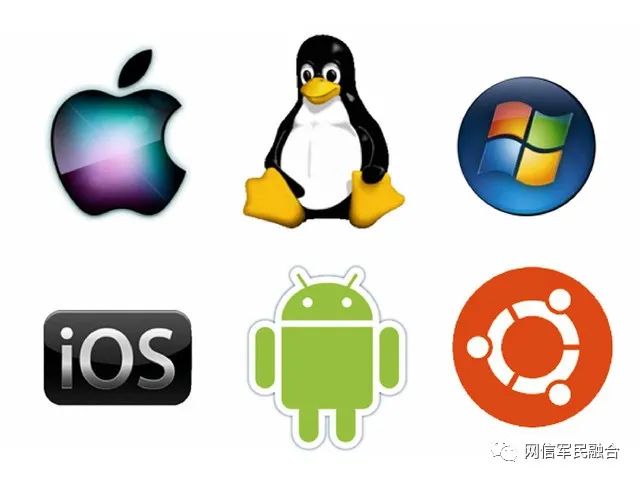Computer operating systems are basic software, divided into closed-source and open-source categories.
Broadly, operating systems include: computer (PC, workstation, server) systems, mobile systems (e.g., HarmonyOS), and embedded systems. This article only addresses computer operating systems.
The functional role of a computer operating system is to serve as an interface between users and computer hardware resources, managing and scheduling hardware resources, and providing a runtime environment for application software. Operating systems are considered basic software, comprising system-level programs that shield users from the complexities of underlying hardware and provide programming interfaces and operation entries. The operating system controls the processor (CPU) scheduling system resources, regulates the timing of application program execution, and determines the allocation of processor time (CPU time) to various programs. Operating systems must be compatible with underlying hardware and application software to realize computer functionality.
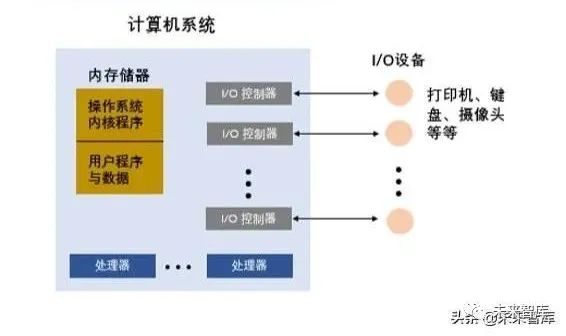
Based on whether the core code is open, operating systems can be classified into two categories: open-source systems and closed-source systems.
1. Closed-source Operating Systems: Code is not open, represented by Microsoft Windows.
The Windows operating system is developed by Microsoft’s internal research team, along with supporting application software like Office. In terms of ecosystem development, Intel and Windows have long collaborated to form the Wintel system, leading the global PC market share.
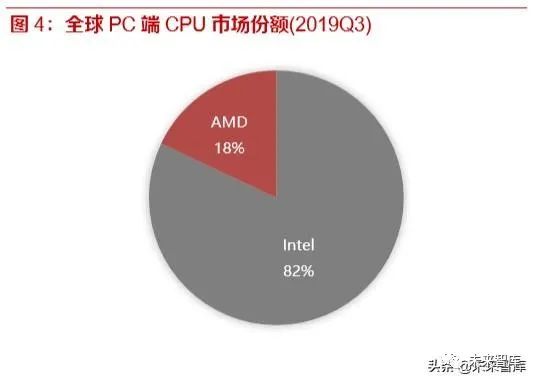
Access in Windows systems is divided into User mode and Kernel mode.User-level applications run in User mode, while system-level programs run in Kernel mode. Kernel mode allows access to all system memory and CPU instructions. Windows systems have evolved from the early 16-bit and 32-bit versions to the now-popular 64-bit, with system versions ranging from the initial Windows 1.0 to Windows 95, Windows 98, Windows 2000, Windows 2003, Windows XP, Windows Vista, Windows 7, Windows 8, Windows 8.1, Windows 10, and Windows Server enterprise-level operating systems, continuously updating.
The greatest advantage of Windows systems is their graphical interface, which makes operation very convenient for ordinary users.Compared to most Linux systems, installing commonly used software and system settings on Windows does not require inputting system commands via the command line; it can be done simply by clicking buttons. Today, the vast majority of common software, specialized software, and underlying hardware support the Windows operating system, forming a powerful Windows ecosystem.
2. Open-source Operating Systems: Code is freely open, represented by the Linux operating system.
The Linux kernel was released by Linus Torvalds in 1991, with the code publicly available for free, contributed by developers worldwide, and has become one of the most widely influential open-source software projects. Based on the Linux kernel, different development communities (open-source communities, enterprises, individuals, etc.) make certain modifications and additions to the kernel code, incorporating GUI (graphical interface), applications, and other components, forming corresponding Linux operating system distributions.
There are derivative relationships between different versions of Linux systems, leading to major families like RedHat, Slackware, and Debian, with notable versions within each family, such as Ubuntu, SUSE, CentOS, Red Hat Enterprise Linux, and Fedora.
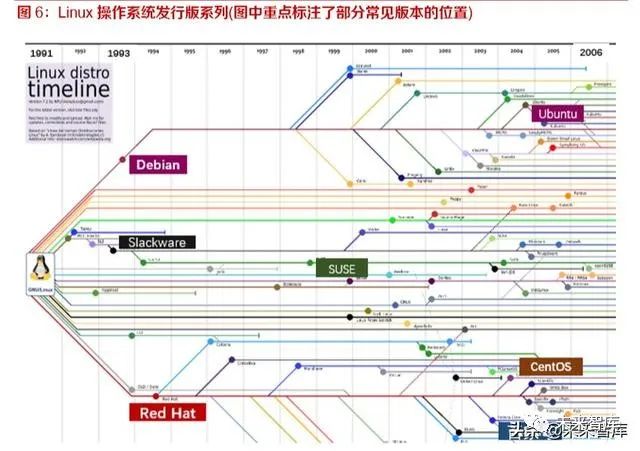
The Linux kernel is an open-source project contributed by developers globally (enterprises, groups, independent developers).The official organization for Linux is the Linux Foundation, a non-profit alliance that coordinates and promotes the development of the Linux system, as well as advocates, protects, and standardizes Linux. The Linux Foundation was jointly established in 2007 by the Open Source Development Labs (OSDL) and the Free Standards Group (FSG).
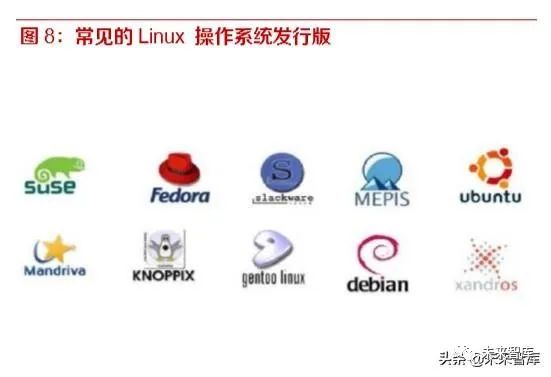
The open-source community is the source of innovation and the primary development venue for the Linux system.Linux operating system distributions are divided into community versions and commercial versions. There are many community versions, primarily developed and maintained by the open-source community. A few commercial versions (such as Red Hat Enterprise) are further optimized from community versions. Overall, whether or not commercial activities are involved, the open-source community is the source of innovation and the main development venue for Linux distributions. Mature open-source communities are usually managed by corresponding open-source foundations (or project committees). Open-source foundations set rules for development communities, manage resources, facilitate potential business connections, and protect the healthy operation of the community. Community open-source foundations (committees) are generally supported and decision-supported by open-source contributors.
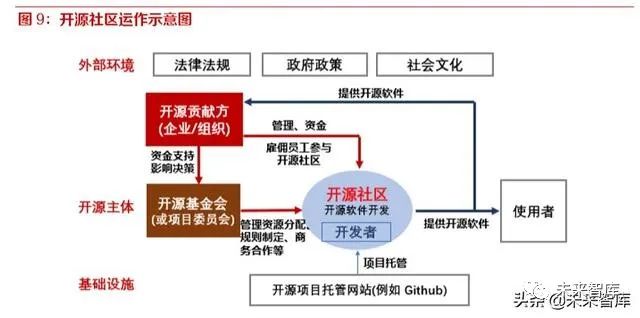
Many open-source communities have a leading enterprise behind them, providing funding and research support, and even directly assigning employees to participate in open-source projects.For example, one-third of the core developers in the Fedora community are official employees of Red Hat. By funding and maintaining open-source communities, enterprises can leverage their research capabilities, attracting more external contributors to participate and expanding the source of ideas; on the other hand, open-source community versions also become important means for enterprises to expand their technical influence.
The Linux operating system consists of four parts: kernel, shell, file system, and applications.The kernel is the core of the operating system, unlike Windows’ kernel, the Linux kernel not only implements process scheduling, memory management, interrupt handling, and exception trapping but also implements process management, process communication mechanisms, virtual memory management, file system drivers, and various device driver subsystems such as USB, networking, and audio, determining the overall system performance and stability. The shell is the user interface of the system, providing an interface for users to interact with the kernel, receiving user input commands and passing them to the kernel for execution.
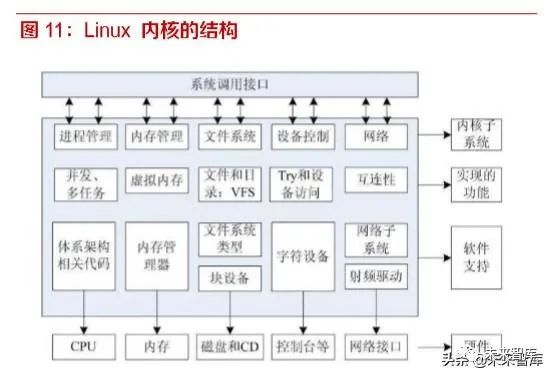
The main advantage areas of the Linux operating system are servers and embedded systems.According to statistics from the Linux Foundation, 90% of global public cloud platforms use Linux systems, 99% of supercomputers, and 62% of embedded devices are also based on Linux. Major cloud service providers such as Amazon AWS, Microsoft Azure, Google Cloud Platform, and Alibaba Cloud offer Linux system solutions. More than 54% of all applications running on global public cloud platforms operate on Linux virtual machines. Even nearly 30% of Microsoft Azure’s virtual machines are based on Linux. According to IDC’s statistics in 2017, among the global server operating system usage share (free + paid), 68% are Linux server operating systems.
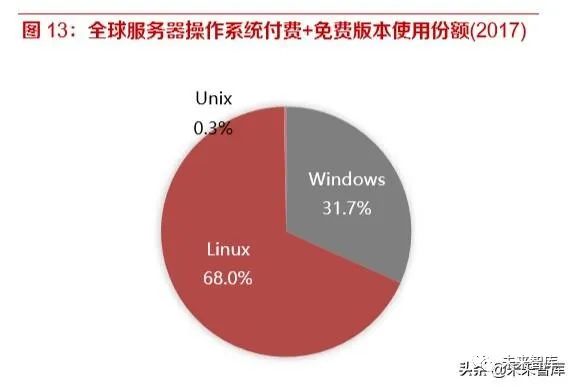
The popularity of the Linux operating system in the server field is mainly due to three aspects:
1) Innovation aspect, brainstorming.Global developers have maintained continuous updates to the Linux kernel, providing ample innovation momentum. According to GitStats analysis, as of September 2018, more than 19,000 developers have contributed code to the Linux kernel, spanning over 1,500 organizations/enterprises worldwide. The widely distributed developers, from different perspectives, supplement the Linux kernel, allowing it to quickly adapt to changes in the server field.
2) System code can be modified and customized, allowing users high freedom to utilize computer resources.Users of the Linux operating system can easily view the system code, freely modify it to fix common issues, or develop their own programs and add them to the Linux operating system. Compared to closed-source systems like Windows, Linux supports users’ extensive freedom in utilizing computer resources, allowing professional users to build and customize servers, thus gaining favor from internet companies and cloud computing companies.
3) High operational efficiency, low maintenance costs.The Linux system operates with high efficiency on servers, being relatively lightweight; unless there are issues with hardware resource allocation, system freezes are rare. Moreover, the Linux system inherently supports virtualization. Therefore, on server clusters, the operational maintenance costs of Linux systems are comparatively low.
4) Security.Linux was designed from its development roots as a multi-user system, where system administrators and the root user have system management privileges. Linux is open-sourced to global developers, with system files being documents; through multiple screenings and updates by global developers, the possibility of “backdoor implants” is largely eliminated. In practical applications, immature Linux operating systems may indeed have security issues, which are also related to the document nature of the system. For example, the root user privileges and sudo commands can inadvertently modify Linux system documents, potentially adversely affecting other users or the entire system. Therefore, mature Linux operating system solutions need to design preventive measures for such properties to appropriately shield permissions. However, there are essentially no insurmountable obstacles to designing these security properties.
Source: Independent and Controllable News
Scan to subscribe to “Cyber Information Military-Civil Integration” magazine ↓↓↓
Important Note: Scan to subscribe to the magazine, invoices are issued by the handling post office.
